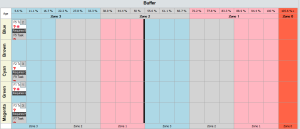Understanding the Health Check - Phase 8: Buffer Management - Questions
Question One
Does the bottleneck suffer when surges wipe out the timing of pre-constraint work?
Health Check Answer Options
- Yes, the constraint normally runs smoothly, but surges can throw everything back into chaos
- We know when we have deep buffer penetrations, but we tend to respond slowly / too late
- We have a secondary management process for handling deep buffer penetrations immediately
Clarifications
- If you have not achieved Phase 8, your constraint schedule sometimes releases surges of work that create queues in your operations.
- These queues propagate through your system and result in expediting. When this happens, operational performance drops.
- As you progress with Phase 8, your system makes the presence of the surge travelling through your system visible, but your people react slowly and variably to these indicators.
- Achieving Phase 8 means you have processes that are implemented in a consistent and timely manner so that you handle surge variations calmly and reliably.
Question Two
Do managers push work into the system, even when there’s no capacity?
Health Check Answer Options
- Yes, the work has to be done, it just has to go in!
- We do gate release, but managers do panic occasionally and force work in
- No; we have a separate process for handling surges and elevating the constraint
Clarifications
- If you have not achieved Phase 8, work is forced into the system, despite a lack of capacity to complete it, and employees are forced to ‘work faster’ or ‘work harder.’
- If you have achieved Phase 8, managers make effective and calm decisions and focus on the right jobs at the right time, rather than forcing work upon an already loaded system.
Question Three
Do you have logs of buffer penetration events?
Health Check Answer Options
- No, we know they happen but they are not logged, we micro-manage them as they occur
- Not really logged, but we think we know the major causes of penetration events
- Yes, we have a log and we do analyse and resolve root causes
Clarifications
- If you have not achieved Phase 8, your managers are aware that some jobs are problematic and take longer to complete.
- These exceptions when picked up, and some are picked up late, cause performance problems and we put up with (and try to manage these) as best we can.
- As you progress with Phase 8, you will start to monitor the patterns of behaviour to reduce the variation.
- Achieving Phase 8 means you are proactive about buffer penetration events.
- You monitor buffer patterns and log degradations in the buffer completion profile to identify the root causes.
- You can see more than just individual occurrences, are predicting the future state of the buffer profile and are acting early to maintain the right buffer profile.
Question Four
Do you re-tune the system parameters (buckets, buffers, decouples) from time to time?
Health Check Answer Options
- Nope, it's been working just fine and we don't want to mess with it
- We adjust the parameters maybe annually, usually after something goes wrong
- Yes, we routinely tweak the parameters, to optimise buffer performance
Clarifications
- If you have not achieved Phase 8, changes to your sales mix cause more and more exceptions that your system is not handling well, and you are deploying more and more resources to handle these exceptions.
- As you progress with Phase 8, you recognise that the changes in your business can cause your system parameters to become incorrect.
- However, you update the parameters periodically by exception usually after you detect a serious problem.
- Achieving Phase 8 means your parameters are dynamic and routinely tuned to match the evolving operational mix variability.
- An advanced user will have automated their system to detect material changes and self-adjust.
Question Five
Can you easily plan resourcing, holidays, etc. in advance?
Health Check Answer Options
- No, if anyone takes leave it's really disruptive
- We have freed up enough capacity that this is less of an issue
- Yes, we use buffer logs to plan leave, recruiting, resourcing, proactively
Clarifications
- If you have not achieved Phase 8, things get difficult when staff take leave, resources seem sparse, and you struggle to maintain client delivery performance.
- As you progress with Phase 8, the spare capacity of your non-constraint resources and your buffers allow you to absorb routine variations such as leave requests.
- Achieving Phase 8 means you can forward plan and accommodate known major disruptions like public holidays and make it seem like business as usual for your people whilst meeting your client commitments.
- Your operations team does not have to change its routine in order to compensate for these disruptions.
